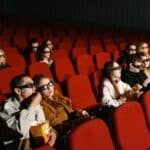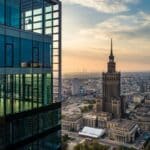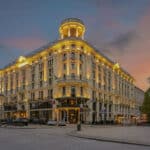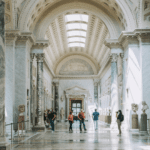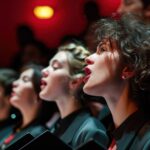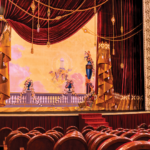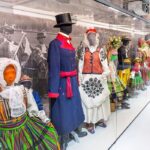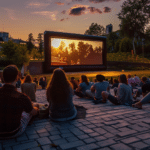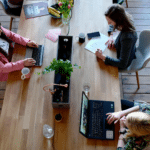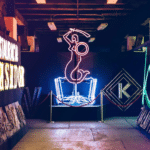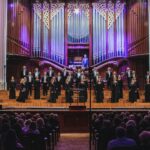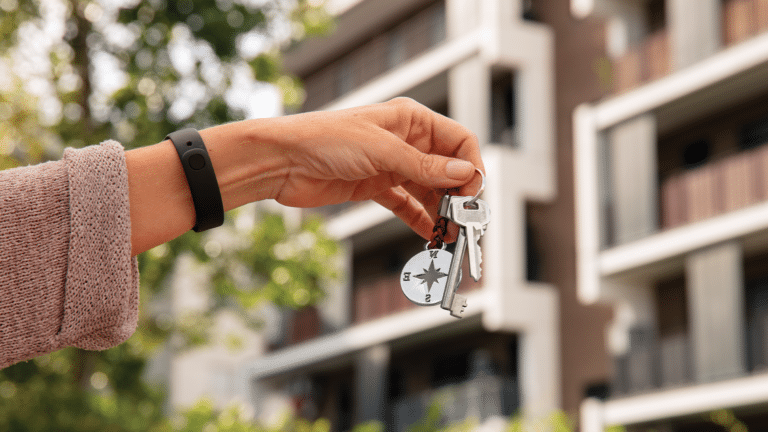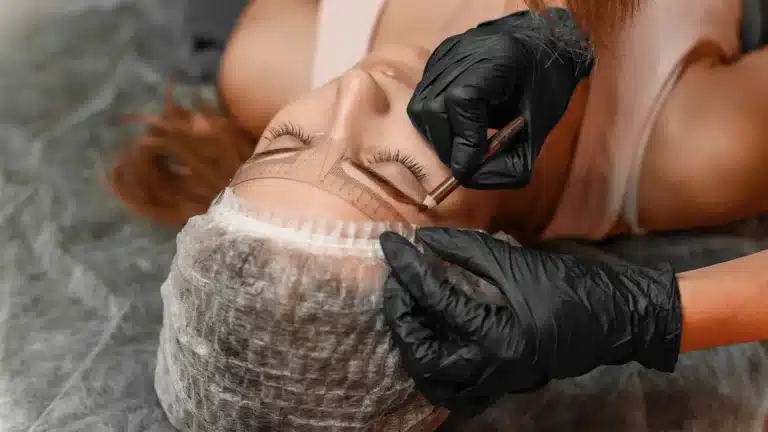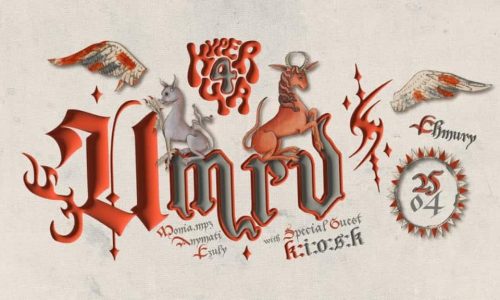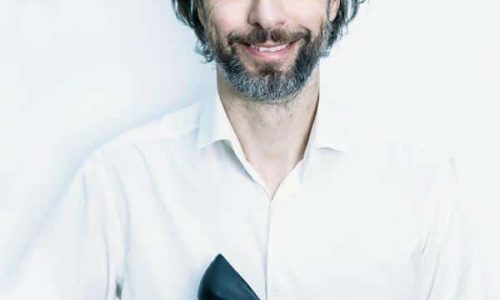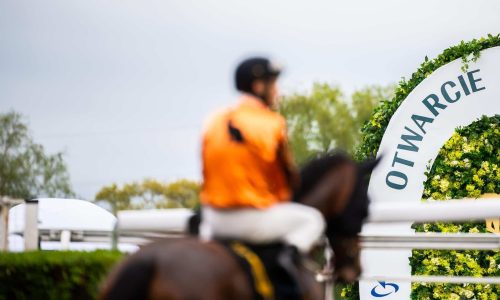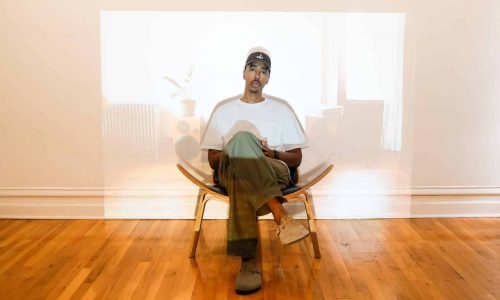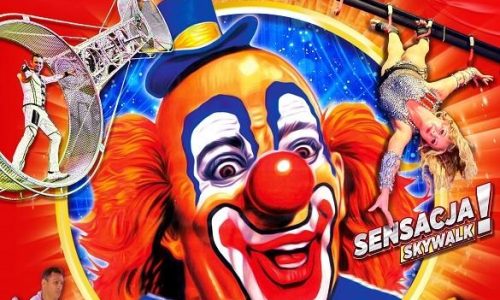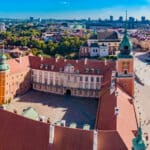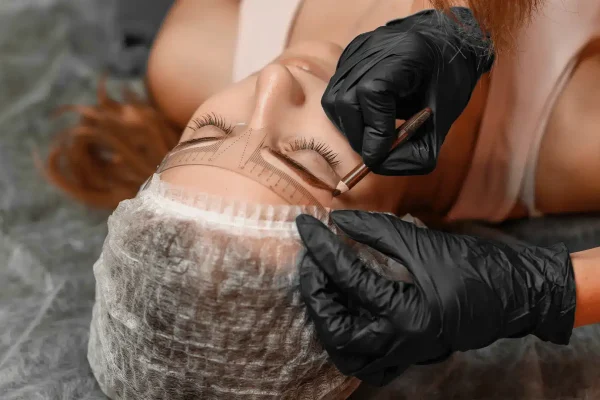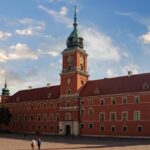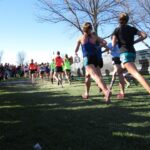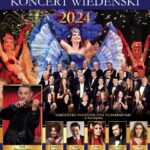Free museums in Warsaw
Free visits to Warsaw museums
- Last updated: April 17, 2025
Free museums in Warsaw
Free visits to Warsaw museums
- Last updated: April 17, 2025
No one needs convincing to the obvious fact that it is worth visiting Warsaw's museums. However, if you need an additional incentive, it may be the information that there are several dozen facilities in the city, which on selected days of the week, and some of them almost every day, you can visit without paying a single zloty for an entrance ticket. Clever culture lovers, with the help of our guide, can take up the challenge and visit all the free museums in Warsaw.
Free museums in Warsaw - economic cultural entertainment
Wandering through halls full of works of art, discovering the secrets of ancient civilisations, exploring the history of Poland and Warsaw or learning the secrets of the world of science and technology - all this and much more completely free of charge. Sounds like the perfect plan? And it is! But to make it not so easy, each institution has its own "free day". That's why we're rushing to help and provide a detailed breakdown. We start with museums that allow free visits almost every day of the week. Then we present the places with one day of free admission, starting on Monday. Free museums in Warsaw waiting for you!
Know that this is not at all about niche establishments with a few exhibits and a 'I'll be right back' note hanging on the door. The guide covers the most important museums in Warsaw. You will find impressive collections and the most interesting exhibitions. Those who have not been to the museum for a long time will be very impressed by the exhibitions, which use the latest multimedia to make the presentations accessible to everyone. The multi-million euro subsidies from the state and European funds for the development and modernisation of the facilities definitely do not go to waste. Come with us on a cultural rally and explore the free museums in Warsaw!
Remember that it is advisable to check the current opening hours on the venue's website before visiting. These are subject to change. Most establishments reserve the need for advance booking for larger groups of visitors (usually more than 9 people). The last possible time of entry before closing is also indicated.
In this guide:
Muzeum Łazienki Królewskie
Well known to Varsovians for its imposing palace and park complex, well connected to almost every part of the city and located a short distance from the city centre - Łazienki Królewskie. The summer residence of King Stanislaw August and the undisputed pearl of Warsaw, it is not without reason that it is called "the happiest place in Warsaw".
Whatever the season, the gardens invite visitors to stroll among nature and classical monuments. These include: The Palace on the Island with the Royal Picture Gallery, the Old Orangery with the Sculpture Galleries or the Myślewicki Palace. Every Friday, the interiors of these buildings can be visited free of charge. Discover royal art collections and architectural masterpieces. This is the ideal place to take a break from the hustle and bustle of the city, enjoying the beauty of nature and the richness of culture.
The gardens are open to the public every day between 6:00 and 21:00 - admission is free. The Royal Łazienki Museum facilities can be admired from Tuesday to Sunday.
Free visit days: gardens - daily, facilities - Friday (ground floor only)
Park Rzeźby w Królikarni
Królikarnia, a branch of the National Museum in Warsaw, is a pearl of classicist architecture from the end of the 18th century. During the reign of Augustus II it housed an animal sanctuary where rabbits were bred for hunting, a custom fashionable at the time. Hence the name of the building.
It houses Xawery Dunikowski Museum of Sculpture, presenting the largest collection of sculptures in Poland, from the 15th century to the present day. A selection of works from the rich collection of the National Museum in Warsaw can be admired during a walk in the romantic park surrounding the palace. It is a green oasis in the heart of Mokotow - an open-air art gallery with sculptures among old trees and ponds. Admission to the park is free and the museum regularly organises various events here. It is an ideal space for lovers of art and nature.
The Królikarnia Palace is only open to the public during special events taking place here. The Sculpture Park, on the other hand, can be wandered through from dawn to dusk, and for free.
Free visiting days: every day (Sculpture Park)
Muzeum Katyńskie
The Katyn Museum in Warsaw is an institution that commemorates the victims of the Katyn Massacre of 1940 in a moving way. It is located on the grounds of the Warsaw Citadel. The facility presents unique exhibits. Including personal items excavated from mass execution sites, documents and photographs. These artefacts tell the story of the victims - nearly 22,000 Polish citizens (including almost 15,000 Polish Army and State Police officers) murdered by the NKVD.
The exhibition, arranged in the historic interiors of the Caponiera, encourages reflection on the tragic events of the Second World War. The institution contributes to the list of "free museums in Warsaw", making it accessible to anyone wishing to explore this painful page of Polish history. It is a place worth visiting to pay tribute to the fallen and to understand the meaning of national memory.
The outdoor exhibition can be visited daily between 10:00 and 16:00, and the permanent exhibition from Wednesday to Sunday during the same hours.
Free visiting days: every day
Muzeum Geologiczne
A place where the history of the Earth comes alive before the eyes of visitors - the Geological Museum of the Polish Geological Institute in Warsaw. Among the thousands of exhibits here, you will find the impressive skeletons of a mammoth and a woolly rhinoceros from the Ice Age, as well as a reconstruction of a predatory dilophosaurus. You can see dinosaur trackswhich once roamed the Polish countryside. They were found near the Świętokrzyskie Mountains. Permanent exhibitions, such as "Geological History of Poland" or "Mineral Raw Materials of Poland", show the fascinating history of our planet as recorded in rocks and minerals. The museum regularly organises temporary exhibitions, educational workshops, vernissages, meetings and even fairs. It can be said to be a veritable mine of knowledge.
The PGI-PIB Museum invites you to visit free of charge on weekdays from 9:00 to 17:30 and on Sundays between 10:00 and 15:00.
Free visiting days: Monday - Friday and Sunday
Dom Spotkań z Historią
The History Meeting House (DSH) is more than just a free museum in Warsaw. A centre of culture and education specialising in twentieth-century Central and Eastern European history, it invites visitors to discover fascinating stories by presenting exhibitions, archival photographs and witness accounts. The DSH runs Poland's largest Oral History Archive. The oldest recordings date back to the 1980s. If you are interested in the history of Poland as seen through the eyes of its inhabitants, be sure to visit the DSH!
The History Meeting House organises various discussions, series of varsavian meetings, feature and documentary film screenings, educational workshops, seminars and conferences. It is also active in publishing. And the local bookshop offers an extremely wide selection of books on the 20th century.
Admission to the exhibitions: Tuesday to Friday 10:00 - 20:00, Saturday and Sunday 12:00 - 20:00, the bookshop is open on the same days from 12:00 to 20:00.
Free visiting days: Tuesday - Friday, Saturday, Sunday
Izba Pamięci przy Cmentarzu Powstańców Warszawy
The Chamber of Remembrance at the Warsaw Insurgents' Cemetery was established as a tribute to the tens of thousands of Varsovians killed during the Warsaw Uprising in 1944. The building, which will be opened to the public in 2022, has received, among other awards, the Architectural Award of the President of the City of Warsaw. It is a branch of the Museum of Warsaw. The Chamber of Remembrance consists of two modern pavilions and a The Wall of Remembrance, on which more than 62,000 plaques with the names of the victims have been placed, leaving room for more as identification research progresses.
The interior of the larger of the pavilions houses two rooms - the Hall of Testimonies and the Hall of Remembrance, where history comes alive through personal accounts and memorabilia. It is a space for reflection on the consequences of armed conflict. The mission of the Chamber of Remembrance is clear - 'crying out for peace'. Krzysztof Wodiczko's audiovisual installation 'Voices of Remembrance', which commemorates the victims of the uprising, requires the presence of an adult guardian for children under 14 due to the weight of the content presented.
The House of Remembrance can be visited from Tuesday to Sunday between 9:00 and 16:00.
Free visiting days: Tuesday - Sunday
Muzeum Legii Warszawa
Legia Warsaw is a sports club that needs no special introduction. However, not everyone knows that the glorious history of Polish and world sport associated with the club can be explored in the Legia Museum located under the Northern Stand (Żyleta).
An array of shiny trophies, medals, commemorative plaques, large-format photographs of players, original uniforms, jerseys, boots, gloves. You'll find artefacts associated with great footballers such as. Kazimierz Deyna or Lucjan Brychczy, but also representatives of other disciplines, such as wrestler Andrzej Wroński's first Olympic gold medal in Seoul in 1988. You can have your photo taken against the background of a motorbike from the 1930s. It is a souvenir of the Legia motorbike section. In addition to the permanent exhibition, temporary exhibitions are also held here. New artefacts regularly add to the museum's collection.
The Legia Museum can be visited free of charge on weekdays from 11:00 a.m. to 5:00 p.m. The museum is closed on weekends and match days.
Free visiting days: Monday - Friday
Muzeum Historii Medycyny Warszawskiego Uniwersytetu Medycznego
It is the only institution of its kind in the city, open to all visitors. You don't have to be studying or practising medicine to explore the collections gathered in the Library and Information Centre building on the vibrant academic campus of Warsaw Medical University. Here you will see 4,000 diverse artefacts such as manuscripts, old medical prints dating back to the 17th century, medical instruments, archives, iconographies, documents of social life, as well as anatomical theatre (anatomy study area).
Among the temporary exhibitions it is worth mentioning are those devoted to the history of the academic teaching of medicine in Warsaw and to the mysteries of the brain. The Museum also organises lectures, seminars and thematic walks, bringing the history of medicine and its eminent creators closer.
The permanent exhibition on the ground floor and the temporary exhibitions on the first floor are open to the public from Monday to Friday from: 9:30 - 15:30.
Free visiting days: Monday - Friday
Centrum Pieniądza NBP
The Sławomir S. Skrzypek Centre of Money of the National Bank of Poland. Skrzypek - a modern educational and exhibition facility that will take you on an amazing journey through the history of money and economics. The Centre is located in the premises of the National Bank of Poland at Świętokrzyska Street.
An area of more than 2,000 m² houses thousands of unique exhibits, from ancient coins to modern means of payment. Interactive exhibitions allow visitors to understand the mechanisms governing finance, as well as learn the secrets of banking and the functioning of the stock exchange. One of the attractions is the possibility to raise 12-kg gold bar. You can also enter the bank vault. The centre offers audio guides in several languages, making the tour even more accessible.
The NBP Money Centre is open to the public free of charge from Tuesday to Sunday from 10:00 to 18:00, and even longer on Thursdays until 20:00.
Free visiting days: Tuesday - Sunday
Stacja Muzeum
If you want to know railway history, be sure to visit the Museum Station located on the premises of the former Warszawa Główna Osobowa railway station at 3 Towarowa St. The museum presents an impressive collection of over 50 historical locomotives and carriages. You can admire them in the open-air museum.
Among the exhibits are unique models. Among them are Poland's oldest steam locomotive from 1882 and a presidential saloon, offering an insight into the travel of the elite of yesteryear. The interiors of the museum house a rich collection of uniforms, railway models, historical tickets and communication equipment, which bring the culture and technology associated with railways closer. Anyone interested in the subject of railway history can explore the museum's collections and rolling stock without spending a penny. By making Monday a free admission day, the Museum Station has joined an esteemed group including free museums in Warsaw.
The museum station is open to the public every day from 9am to 5pm.
Free visit day: Monday
Żydowski Instytut Historyczny
In the heart of Warsaw, the historic building of the former Central Judaic Library houses the Emanuel Ringelblum Jewish Historical Institute. It is a veritable treasury of knowledge about the thousand years of Jewish presence on Polish soil. The Institute, founded in 1947, continues the mission of the Central Jewish Historical Commission established in 1944. The collections of the Archive of the Jewish Historical Institute include documents created in the Jewish community in Poland from the 18th century to the present day.
The Institute houses the priceless Ringelblum Archive - a unique collection of documents from the Warsaw Ghetto, listed on UNESCO's Memory of the World list. Visitors can admire the permanent exhibition "What we could not shout to the world", presenting these moving testimonies. The Institute also regularly organises temporary exhibitions, lectures and workshops, bringing the richness of Jewish culture closer to the public.
The Jewish Historical Institute is open from Monday to Thursday from 9am to 6pm, on Friday until 4pm and on Sunday from 10am to 6pm.
Free visit day: Monday
Muzeum Narodowe w Warszawie
It's the largest museum in Warsaw and one of the largest and oldest in Poland. A treasury of art, offering a rich collection from antiquity (Egyptian, Greek or Roman works) to the present day - a total of 830,000 museum pieces and many cultural events, including, of course, vernissages. Among the exhibits you will find masterpieces by Polish masters as well as a gallery of foreign paintings. Including several paintings from Adolf Hitler's private collection.
Particularly noteworthy are the Faras Gallery, displaying unique paintings from a Nubian cathedral, and the Gallery of 19th Century Art with paintings by artists such as Jan Matejko and Józef Chełmoński. The facility has custody of several branches. The east wing of the building is occupied by the Museum of the Polish Army in Warsaw.
The National Museum welcomes visitors to its certainly not humble abode from Tuesday, when the permanent exhibitions can be visited free of charge, until Sunday from 10 a.m. to 6 p.m., and until 8 p.m. on Friday.
Free visit day: Tuesday
Muzeum Marii Skłodowskiej-Curie
In the heart of Warsaw's Old Town, at 16 Freta Street, there is a unique place - the Maria Skłodowska-Curie Museum. The institution also conducts educational activities. It was here, in an 18th century tenement house, that the two-time Nobel Prize winner, pioneer of research into radioactivity and one of the most eminent women in the history of science, was born.
The museum exhibition takes visitors into the world of Marie Skłodowska-Curie. It presents her life and achievements. Among the exhibits are personal mementos of the scientist. Among them is a leather handbag donated to her in 1921 by the Union of Polish Women in America, as well as sculptures by well-known Polish artists, including Ludwika Nitschowa and Zofia Wolska. One of the most fascinating elements of the exhibition is reconstruction of the parisian laboratory Mr and Mrs Curie. There you can feel the atmosphere of a place where scientific breakthroughs were made.
The legacy of the eminent Polish woman can be explored at the museum from Tuesday to Friday between 12:00 and 18:00. At weekends, the facility welcomes visitors between 11:00 and 18:00.
Free visit day: Tuesday
Narodowe Muzeum Techniki
In a monumental edifice well known to all Varsovians, the Palace of Culture and Science Many cultural institutions have their headquarters here. It is also home to the largest technical museum in Poland, the National Museum of Technology.
With more than 15,000 exhibits, the museum presents visitors with the history of technology - from astronomy and physics, to mining and metallurgy, to IT and energy. Here you will see, among other things, antique steam engines or the first computers. One of the main attractions is the exhibition "Poles' contribution to the world's technical and scientific heritage". It shows the innovation of native engineers over the centuries. With its modern arrangement and interactive elements, the museum attracts both technology enthusiasts and families with children, offering educational entertainment at the highest level. After visiting the museum, you can continue your visit to PKiN by going, for example, to a screening at Warsaw's iconic cinema - Kinoteka.
The National Museum of Technology welcomes all explorers from Tuesday to Sunday from 9:00 a.m. to 6:00 p.m. It is worth a trip here on Tuesday, when the facility opens its permanent exhibitions functioning as a free museum in Warsaw. Just bear in mind that you also have to collect your entrance tickets at the box office on that day.
Free visit day: Tuesday
Muzeum Karykatury
Near Castle Square, at 11 Kozia Street, is the unique Eryk Lipiński Museum of Caricature. It is the only institution in Poland dedicated to the art of caricature and satirical drawing. It has already collected over 25,000 works by both Polish and foreign artists, from the 18th century to the most recent. Throughout the world, institutions with this profile are...
The museum's collection includes works by such masters as Maja Berezowska, Andrzej Mleczko and Zbigniew Lengren. Regularly organised temporary exhibitions present both classic and contemporary faces of caricature, showing its diversity and evolution over the years. It is a place that with with humour and detachment provides a glimpse into the reality around us, providing both entertainment and reflection. For all lovers of satire and intelligent humour, a visit to this museum will be an unforgettable experience.
Apart from Monday, the Caricature Museum is open to the public every day from 10:00 - 18:00, except on Thursday when the hours are 12:00 - 20:00.
Free visit day: Tuesday
Zamek Królewski
The majestic Royal Castle - a symbol of Polish history and culture. For centuries, this baroque-classical residence served as the seat of kings and the venue of the Sejm. During its long history, the Royal Castle has been plundered and devastated many times by foreign armies. Completely destroyed during World War II, it was rebuilt between 1971 and 1984 thanks to the commitment of the public. Today, it delights with recreated interiors from the times of Stanisław August Poniatowski. It displays a rich collection of high-ranking works of art, as well as furniture and fabrics.
Visitors are particularly impressed by the Royal Apartments, full of gold colours and outstanding works of art. The jewels of the Lanckoronski Gallery collection are two paintings by RembrandtAnd after the rearrangement, the gallery is complemented by a new space dedicated to Italian art. However, the castle is not short of works by other masters, such as Canaletto, Bacciarelli, Le Brun or Matejko.
The Royal Route, Lanckoroński Gallery and Kubicki Arcades can be visited from Tuesday to Sunday between 10 a.m. and 5 p.m., and the castle gardens, weather permitting, every day from 10 a.m. to 6 p.m. All permanent exhibitions can be visited free of charge on Wednesday after collecting an entrance pass at the ticket office.
Free visit day: Wednesday
Muzeum Fryderyka Chopina
The Fryderyk Chopin Museum is located in the historic Ostrogski Palace at 1 Okólnik Street. It is a modern institution devoted to the life and work of one of the most eminent composers in history, of whom probably everyone has heard. The institution is part of the Fryderyk Chopin Institute.
The museum exhibition, spread over five levels, combines traditional props with interactive multimedia installations, allowing visitors to enter Chopin's world. Valuable memorabilia include the world's largest collection of manuscripts by a composer, letters, photographs, drawings and prints, personal effects and the last piano belonging to the maestro. Piano recitals are regularly held in the museum's concert hall.
The Fryderyk Chopin Museum opens its doors to the public every day, except Mondays, from 10:00 to 18:00.
Free visit day: Wednesday
Muzeum Literatury im. Adama Mickiewicza
The Museum is located in six interconnected tenement houses in the Old Town Square. The institution's patron, Adam Mickiewicz, one of the nation's foremost bards, is a figure that every Polish man and woman of school age has probably heard of. The mission of the institution is to collect and preserve cultural property, mainly related to Polish literature, and to disseminate the values of literature, science and culture, as well as educational and scientific activities. The institution comprises several departments and museum studios, a library, an audiovisual room and exhibition halls.
The permanent exhibition dedicated to Adam Mickiewicz presents more than 500 exhibits, including the only existing manuscript of the poem "Grażyna" and a page of "Pan Tadeusz". You will also see book collections and objects from the offices of writers such as Julian Tuwim, Leopold Staff, Maria Dąbrowska and Witold Gombrowicz, as well as the only surviving film featuring Witkacy digitally reconstructed in 2015. The museum offers visitors not only manuscripts and memorabilia of great writers, but also fragments of Gothic walls and wall paintings from the early 16th century.
The museum declares that free visits to the headquarters and its branches are possible on Wednesday. On Tuesday, Wednesday, Friday and at the weekend, the institution invites visitors from 10:00 to 17:00, and on Thursday from 12:00 to 20:00.
Free visit day: Wednesday
Muzeum Pałacu Króla Jana III w Wilanowie
King John III Palace Museum in Wilanów
On the outskirts of Warsaw, in picturesque Wilanów, rises the Baroque Palace of King John III - a pearl of architecture and a witness to Poland's rich history. The royal residence, surrounded by extensive gardens, delights not only from the outside, but also with its unique interior design and rich art collections. Walking through the palace's chambers and gardens, you can travel back in time, discovering the splendour of the era of John III Sobieski.
Numerous cultural events, temporary exhibitions, workshops for various age groups and demonstrations. Particularly noteworthy outdoor light exhibitionwhich has been attracting locals and visitors for several years. The phenomenal mappings on the palace façade are very popular. The Royal Garden of Light is a must-see attraction during the winter season.
The chateau can be visited every day except Tuesday (when the building is closed) from 10:00 to 16:00, while the park and the courtyard of the chateau can be visited 7 days a week at hours that vary according to the season. On Thursdays, you can count on free tours of the chateau, the historic gardens and the park after collecting an entrance ticket from the ticket office in the museum area.
Free visit day: Thursday
Muzeum Powstania Warszawskiego
The Warsaw Uprising Museum will take you right into the middle of the dramatic events of August 1944, and bring you closer to the post-war communist terror and the fate of the insurgents in communist Poland. Located in a restored tramway power station from the early 20th century, the museum is a testament to history and a tribute to those who fought and died for a free Poland and its capital....
The exhibition takes you through the stages of the uprising, capturing the atmosphere of those days. Particularly moving is the replica of a sewer. It allows you to feel the hardship of the insurgents' underground passages. The museum uses modern audiovisual techniquesThis makes it easier for young people to receive and assimilate the subject matter. It not only documents the history of the Warsaw Uprising, but also conducts scientific research and educational activities.
Join the several million people who have already visited this unique museum in Warsaw. Apart from Tuesday, when the facility is closed, you can come here every day from 8:00 to 18:00.
Free visit day: Thursday
Fotoplastikon Warszawski
This is a branch of the Warsaw Rising Museum hidden in an annexe of the Hoser building on Jerozolimskie Avenue. Its main exhibit is Poland's only active photoplasticon from the early 20th century. Through the viewfinders of this wooden device, you will see three-dimensional photographs from different eras and corners of the world. Stereoscopy is an imaging technique that gives the impression of normal spatial vision. You could say, therefore, that the photoplasticon works like a time machine.
The collection includes more than 10,000 stereoscopic photographs showing exotic journeys from the turn of the 20th century, as well as Warsaw in various historical periods and contemporary photographs. A permanent exhibition of photographs of the former capital is presented every Sunday and Monday, and thematic exhibitions change at least once a month. Fotoplastykon is also an educational and artistic space, a venue for intimate concerts, meetings, workshops or lectures.
The museum is open daily, except Tuesday, from 10:00 to 18:00.
Free visit day: Thursday
Muzeum Jana Pawła II i Prymasa Wyszyńskiego
The Museum of John Paul II and Primate Wyszynski, located in Wilanów, under the dome of the Temple of Divine Providence, was officially opened in 2019. It is therefore a relatively new place on the cultural map of Warsaw. It should be added that it is the highest museum in Warsaw, 26 metres above the ground - literally closer to the sky.
The museum takes a modern look at the profiles of two prominent figures of the 20th century Catholic Church. The exhibition covers the period from the birth of Stefan Wyszyński in 1901 to the death of John Paul II in 2005. It shows the key moments of their lives against the background of Poland's troubled history. Thanks to multimedia presentations and rich collections, the museum offers a fascinating journey through one hundred years of our country's history.
The facility welcomes visitors from Tuesday to Friday from 10:00 to 17:00, at weekends from 12:00 to 19:00.
Free visit day: Thursday
Muzeum Historii Żydów Polskich POLIN
The Museum of the History of Polish Jews POLIN is not only a traditional museum building, but also a cultural and educational centre, a meeting place and a place for dialogue. Its mission is to build bridges between people, cultures and between the past and the future. Situated in Muranów, in the heart of the former Jewish quarter, it is delightfully modern architecture and innovative approach to the presentation of Jewish history. From the arrival of the first Jewish merchants on Polish soil around 960 to the recent history of the Jewish community in the Third Polish Republic.
Unlike similar institutions in Jerusalem or Washington D.C., Polin does not focus on World War II and the Holocaust, but on presenting the contribution of Jews to Polish culture, science and economy. The exhibitions are full of interactive installations, authentic artefacts and multimedia presentations. They engage visitors of all ages. It costs a bit of effort to wander through the entire facility, but free rentals are available on site mobile chairs and rest during the tour.
The facility represents the free museums in Warsaw on Thursdays. The Polin Museum is open every day, except Tuesday, from 10:00 to 18:00, and on Saturday between 10:00 and 20:00.
Free visit day: Thursday
Muzeum Warszawy
The facility has as many as nine branches. These include the Centre for the Interpretation of Historical Monuments, the Museum of Pharmacy, the Museum of Printing, the Museum of Wola, the Museum of Warsaw Prague and the House of Remembrance. The headquarters of the Museum of Warsaw invites you to discover the fascinating stories hidden among the historic tenements of the Old Town Square 28-42. It is here, in the eleven restored buildings included on the UNESCO World Heritage List, that the rich history of the city is hidden. The museum's main exhibition presents "Things of Warsaw". These are unique objects that show the evolution of the city and the fate of its inhabitants.
Restored between 2010 and 2012, the cellars, located in the museum's main building under the eight townhouses on the Dekerta side, are now the most important of the five elements of the Cultural Route of the Old Town Cellars. During the work, a treasure trove of 1,211 coins minted between the first half of the 17th century and the early 18th century and a well from the second half of the 17th century were found here.
The magnificent permanent exhibition is open to the public every day except Monday. Tuesday, Wednesday, Friday 9:00 a.m. - 5:00 p.m., Thursday 9:00 a.m. - 7:0 p.m. Saturday, Sunday 11:00 a.m. - 6:00 p.m. The museum expands its sizeable list to include free museums in Warsawwhere the day of free visit to the permanent exhibition is Thursday. On that day, the temporary exhibition can be admired for a symbolic gold donation.
Free visit day: Thursday
Muzeum Farmacji im. mgr Antoniny Leśniewskiej
The patron of the establishment, Antonina Leśniewska, was the first Polish woman to obtain the rank of provost and then master of pharmacy. She was the founder of the first pharmacy in the world to employ only women (St Petersburg, 1901).
The exhibition includes reconstructed interior of a pharmacy from the inter-war period. It presents original furniture, tools and pharmacy utensils in three rooms. In total, there are around 2,500 museum artefacts and an extensive collection of books in the museum library. You will also see the oldest surviving pharmacy furniture in Warsaw dating from the turn of the 18th and 19th centuries. Visitors can delve into the origins of medicines, poisons and drugs, as well as learn about the history of traditional Japanese Kampo medicine.
The institution is one of the smallest museum departments in the city, but it certainly deserves to be included in its list of "free museums in Warsaw" to visit on Thursday. Anyway, the ticket prices on the other days (Tuesday - Saturday, 10:00-18:00) won't ruin your budget either.
Free visit day: Thursday
Muzeum Drukarstwa
A must-visit point for lovers of traditional paper books. As well as for anyone who wants to learn about the history of printing, see the antique printing pressesfonts, typesetters, typesetting tools and other exhibits related to the art of printing, editing, graphic arts and bookbinding.
The museum offers not only exhibitions, but also linocut workshops. During these sessions, participants create their own prints and print them on an antique printing press. Through interactive educational activities, both children and adults can explore the secrets of the art of printing, learning about the techniques and materials used throughout the ages.
The Museum of Printing is located on Ząbkowska Street, well known to Varsovians, in the heart of Praga. You can visit it from Tuesday to Sunday from 9:00 a.m. to 5:00 p.m. Admission is free on Thursday, and on the other days ticket prices are very affordable, even symbolic. In addition, every Tuesday at 3 p.m. you can count on guided tours of the exhibition included in the entrance fee.
Free visit day: Thursday
Muzeum Warszawskiej Pragi
The Museum of Warsaw's Praga is a branch of the Museum of Warsaw dedicated to the rich history of Praga - the right bank part of the city from the 16th century to the present day. In the Praga History Room, an impressive model of the 18th century districts of Golędzinów, Praga and Skaryszew awaits you. In turn Praga Market Hall will transport you into the world of ancient bazaars and crafts. It showcases unique exhibits such as a kaiser baking machine and a stick for measuring horses at the withers. Don't miss the historic cellars with preserved polychrome paintings of former Jewish houses of worship.
Finish your visit at the top of the historic building that houses the museum and admire Prague from the viewing terrace.
The Museum of Warsaw's Praga is open on Tuesday, Wednesday and Friday from 9 a.m. to 5 p.m., on the weekend between 10 a.m. and 6 p.m., and on Thursday, which is a free visit day, the facility is open from 11 a.m. to 8 p.m.
Free visit day: Thursday
Muzeum Woli
The historic Neo-Renaissance palace on Srebrna Street is the headquarters of the Wola branch of the Warsaw Museum. Two large exhibition halls, an educational room and a workshop room are fully equipped with modern multimedia. The museum, as is not difficult to guess, focuses on the people, places and events shaping the identity of Wola. It covers the period from the Middle Ages to the present. At the same time, it examines and addresses the changes taking place in the district. A permanent element of the exhibition is Wolski Cabinet divided into 15 thematic zones. The 'Commerce' section illustrates the panorama of Wola's commerce from the legendary bazaar, Kercelak, through the PDT to contemporary shopping and business centres.
The institution carries out intensive educational activities. It organises temporary exhibitions, meetings, discussions, workshops, museum lessons and walks. The Wola Museum explores the notion of contemporary locality by engaging not only the indigenous inhabitants of Wola and Warsaw from different age groups, but also new residents of the city and foreigners.
You can visit the Wola Museum on Tuesday, Wednesday and Friday between 9 a.m. and 6 p.m. On weekends, the facility operates from 11 a.m. to 8 p.m. On Thursday, during the museum's opening hours (11 a.m. to 7 p.m.), you will only pay one zloty for entry. Therefore, we had no reluctance to add this facility to the list "museums for free in Warsaw".
Free visit day: Thursday (admission: 1 zl)
Centrum Interpretacji Zabytku
The Centre for Heritage Interpretation is based in a revitalised former boiler house in the Old Town. It is just 200 m from the mother museum of Warsaw. The Centre offers a modern permanent exhibition, entitled "Destruction and reconstruction of the Old Town". It shows the phenomenon of the reconstruction of the Old Town after World War II, which lasted only five years.
The exhibition combines traditional, static elements, such as charts, large-format photographs, plans and drawings, and multimedia elements, including presentations, photo viewers or thematic animations. It is also the starting point of the cultural trail of the Old Town cellars. With regular lectures, educational workshops and themed walks, the Centre is an inspiring place for anyone wishing to explore the history of the city.
The Heritage Interpretation Centre welcomes visitors on Wednesday and Friday from 9 a.m. to 5 p.m., on Saturday and Sunday between 11 a.m. and 5 p.m. You can count on a free tour on Thursday from 9 a.m. to 6 p.m.
Free visit day: Thursday
Centrum Sztuki Współczesnej Zamek Ujazdowski
The CCA is one of the most important centres of its kind in Poland. It focuses on creating, exhibiting and documenting the contemporary Polish and foreign art. In the spacious interiors of the late Baroque castle with its 13th-century roots, there is also a studio cinema, showing experimental films and documentaries. The following events take place here theatrical performances, workshops and discussions. There is an artist-in-residence programme and a bookshop with a wide range of art publications. The park surrounding the castle invites visitors to relax and take a stroll.
The collection includes works by renowned artists such as Krzysztof Bednarski, Magdalena Abakanowicz, Maurycy Gomulicki and Natalia LL. The Centre for Contemporary Art defines itself as a space for creative experimentation, where different fields of art coexist, intermingle and encourage artistic exploration.
The exhibitions of the Centre for Contemporary Art Ujazdowski Castle can be enjoyed from Tuesday to Sunday from 11:00 to 19:00, and on the always free Thursday from11:00 to 20:00.
Free visit day: Thursday
Państwowe Muzeum Etnograficzne w Warszawie
The 'whole world in one place' is waiting for you here. Showing the beauty inherent in diversity and the wealth of cultures from around the globe as a national asset is the main objective of the State Ethnographic Museum. The institution has been successfully pursuing it since 1888 as one of the oldest ethnographic museums in Poland.
Located in a Neo-Renaissance building designed by Henryk Marconi, the museum impresses both with its architecture and the wealth of its collections. The collection comprises over 80,000 exhibits and almost 300,000 archival items. The permanent and temporary exhibitions are interdisciplinary and have a wide variety of themes. The permanent exhibition "Celebration Time in the Cultures of Poland and Europe" is the largest exhibition in the history of the museum. It presents costumes, props, religious, utilitarian, decorative and other objects related to traditions of celebration. The "Order of Things", on the other hand, exhibits artefacts related to craftsmanship. There is also a cinema room and a library. In addition, fairs, author meetings, workshops and seminars are held.
The museum is open Tuesday to Friday from 10:00 to 18:00, Saturday and Sunday from 11:00 to 18:00.
Free visit day: Thursday
Zachęta Narodowa Galeria Sztuki
One of the leading cultural institutions in Europe, whose mission is to present, promote and disseminate the contemporary art. Zachęta's history dates back to 1860, when the Society for the Encouragement of Fine Arts was founded. The 1900 exhibition building, designed by Stefan Szyller, is home to an impressive collection of almost 3,700 works of painting, sculpture, installation, video, graphics or performance. The Zachęta Palace has also witnessed tragic historical events. It was here, on 16 December 1922, that the first President of the Republic of Poland, Gabriel Narutowicz, was assassinated.
Zachęta does not have a permanent exhibition; instead, it regularly holds a variety of temporary exhibitions, both individual and group, of Polish and international artists and problem exhibitions. In this way, it offers visitors a constantly new artistic experience. It has hosted exhibitions by artists such as Marlene Dumas, Luc Tuymans, Yayoi Kusama and Wilhelm Sasnal. The gallery also conducts educational activities, including meetings with artists, film screenings and workshops. It is a place that inspires and encourages the discovery of contemporary art in the heart of Warsaw.
The Zachęta National Art Gallery welcomes visitors from Tuesday to Sunday from 12:00 - 20:00.
Free visit day: Thursday
Muzeum Azji i Pacyfiku im. Andrzeja Wawrzyniaka
The Asia and Pacific Museum in Warsaw is the only place in Poland devoted exclusively to the cultures of Asia and Oceania. The institution was established in 1973 by Andrzej Wawrzyniak. The diplomat and traveller donated his considerable private collection of 4,000 works of art and ethnographic objects to the Polish state. Today, the museum displays 23,000 artefacts. Among the artefacts, you will find a variety of objects from almost all the countries of the Asian continent and much of Oceania. There are masks, weapons, theatre puppets, dishes and books, among others.
Permanent exhibition "Journeys to the East' has been divided into several zones through which one takes a journey. There is a gallery dedicated to South West Asia, a room presenting Central Asia, Mongolia with an original yurt and a collection of museum pieces from Indonesia. The "Sound Zone" is worth seeing. It includes 120 original musical instruments. The institution also organises temporary exhibitions, concerts, workshops and other events, creating a friendly space for meetings and dialogue.
The museum welcomes visitors from Tuesday to Sunday from 10 a.m. to 6 p.m. It must be said that in the statistics "free days in warsaw museums" definitely wins on Thursday. You can also visit the Asia-Pacific Museum free of charge on this very day.
Free visit day: Thursday
Muzeum Niepodległości
Established in 1990 within the walls of the 18th-century Przebendowski / Radziwiłł Palace, the museum presents rich collections documenting the Polish struggle for sovereignty from the time of the Kościuszko Uprising to the present day.
The permanent exhibitions show key moments in the nation's history. "Polonia Restituta" depicts all stages of the the struggle for independence chronologically and the activities of the main Polish political camps. Paintings by prominent Polish painters grace the exhibition. Hanging here are works by Jacek Malczewski and Antoni Kozakiewicz, among others. There is also an impressive patriotic jewellery collection. The exhibition 'With the White Eagle through the Ages' is the history of our emblem enriched with the context of people, places and events. A visit to the Museum of Independence prompts deep reflection on the value of freedom.
The Museum of Independence and two of its branches, the Pawiak Prison Museum and the Mausoleum of Struggle and Martyrdom, are open to the public on Tuesday 10:00 - 17:00, Wednesday 11:00 - 19:00, Thursday to Sunday 10:00 - 17:00.
Free visit day: Thursday
Muzeum Więzienia Pawiak
The Pawiak Prison Museum in Warsaw is a moving and thought-provoking place. It was built on the surviving foundations and preserved fragments of the cellars of the former prison. Most of the original elements found during the deconstruction were used for this purpose. The reconstructed cells and corridors convey the atmosphere of the years of German occupation. The permanent exhibition includes, among others, the Hall...
The permanent exhibition includes, among other things, the Hall of Relics and Gryps. Here you will see authentic objects excavated from the rubble. You will also hear recordings of fragments of secret messages telling the story of the drama suffered by the prisoners. A separate part of the exhibition is a room devoted to the history of the Pawiak tree, the silent world of German crimes. It is a kind of memorial to the murdered. With free audio guides in many languages, including audiodescription and sign language interpretation, the museum is accessible to everyone.
The Pawiak Prison Museum can be visited on Tuesday 10:00 - 17:00, Wednesday 11:00 - 19:00, Thursday to Sunday 10:00 - 17:00.
Free visit day: Thursday
Mauzoleum Walki i Męczeństwa
The Mausoleum of Struggle and Martyrdom in Warsaw takes visitors back to the dark times of the German occupation. It is located in the ground floor of the former building of the Gestapo The Museum has preserved the cells, corridors and interrogation room almost intact. It was here that prisoners from Pawiak and other prisons in the Warsaw district were brought for interrogation, as well as those arrested in street roundups. It was here that many Polish patriots were tortured and murdered.
Multimedia presentations and film shorts such as the moving "Will to survive", convey the atmosphere of those days. The most eloquent is the inscription from one of the isolation rooms, which became the motto of the Mausoleum: "It is easy to talk about Poland. It is more difficult to work for it. It is even harder to die. And the hardest to suffer."
The Mausoleum of Struggle and Martyrdom, like Pawiak, is open to the public on Tuesday from 10:00 - 17:00, Wednesday 11:00 - 19:00, Thursday to Sunday 10:00 - 17:00.
Free visit day: Thursday
Muzeum X Pawilonu Cytadeli Warszawskiej
The Museum of the 10th Pavilion of the Warsaw Citadel is one of the branches of the Museum of Independence. It is another place where the history of Polish national liberation aspirations comes alive within the authentic walls of the former political prison from the partition era.
Erected by order of Tsar Nicholas I after the suppression of the November Uprising, the Citadel, manned by a strong garrison and equipped with several hundred cannons, was intended to strengthen the control of the Russian authorities over the rebellious city. Inmates here included such figures as Jozef Pilsudski, Roman Dmowski, Rosa Luxemburg and Romuald Traugutt, who was one of several hundred people executed on the fortress' slopes. Visitors can see original objectives, corridors and exhibitions dedicated to the struggle for independence.
The museum invites you to explore Polish history in an authentic memorial every day except Monday. Opening hours vary slightly depending on the season.
Free visit day: Thursday
Muzeum Polskiej Techniki Wojskowej
The field branch of the Museum of the Polish Army in Warsaw is a must-see for lovers of militaria and the history of military technology. The Museum of Polish Military Technology, located in the historic Czerniaków IX fort on Powsińska Street, presents an impressive collection of military equipment.
The main part of the outdoor exhibition is heavy equipment. Here you will see, among others, tanks, armoured guns, anti-aircraft rocket launchers, transporters, cannons, aircraft, helicopters and radio stations. Polish-made equipment as well as foreign machines used by Polish soldiers or their opponents. The fort's interiors also house exhibitions on small arms, uniforms and dioramas, and even a flight simulator. If you want to know the reality of military life, this is the right address.
The museum is open daily from 10 a.m. to 4 p.m. The exhibition in the casemate "We did our bit" is closed on Monday and Tuesday. If you are on target free museums in Warsaw Be sure to visit Fort IX Czerniaków on Thursday.
Free visit day: Thursday
Muzeum Historii Polski
Museums for free in Warsaw is an extensive group of establishments, which includes the Museum of Polish History every Friday and on public holidays. The museum's impressive modern edifice was erected on the grounds of the Warsaw Citadel. Its worthy neighbours include: The Museum of the Polish Army, the Katyn Museum and the 10th Pavilion Museum. The 6-storey MHP building has an area of over 44,000 m², and houses, among others, an auditorium, a cinema and theatre hall, a library and a roof terraceIt has won many awards. It is therefore a must-see not only for history buffs but also for architecture lovers. Culinary enthusiasts, on the other hand, should visit the third floor of the museum, where a fine dining restaurant has recently opened restaurant with Polish cuisine - Dialogue.
"1025: The Birth of a Kingdom" is a temporary exhibition now available. It transports visitors to colourful early medieval Poland. At the same time, a 7300 m² exhibition space is in the pipeline, which will become home to 3600 museum pieces. The permanent exhibition is scheduled to open in 2026, and the exhibition scenario will include six galleries. They will tell the story of successive eras starting with the Poland of the Piasts and Jagiellons, focusing on three main themes: freedom, identity and civilisational change.
You can visit the Polish History Museum from Wednesday to Friday from 10:00 to 18:00, and at the weekend from 10:00 to 19:00.
Free visit day: Friday
Muzeum Gazowni Warszawskiej
The Museum of the Warsaw Gasworks is located in Wola in a comprehensively revitalised building from the 19th century. Until 1970, a gasworks operated here. Modern display enables you to understand the process of producing gas from coal. It is worth knowing that gas once not only lit the streets, but also powered the first refrigerators and other appliances.
Here you will see unique exhibits such as gas cookers, cookers and fireplaces, an iron, a coffee roaster and even a hairdresser's curling iron on a wall heater. These antique objects of everyday use will allow you to feel the authentic atmosphere of 19th-century Poland. Europe's largest gas meter has also been preserved here. The facility takes a closer look at the figure of the eminent Polish inventor and independence activist Ignacy Łukasiewicz. He is the patron of the PGNiG Foundation. The Museum of the Warsaw Gasworks is also a thriving educational zone. Research and art workshops for children and families are organised here.
The facility feeds into the list of "free museums in Warsaw" every Friday offering non-ticketed admission to the exhibitions without a guide between 10:00 and 18:00. During the same hours, the museum is open every day except Mondays.
Free visit day: Friday
Muzeum Sportu i Turystyki
If you want to visit free museum in Warsaw at the weekend, direct your steps to the Olympic Centre in Żoliborz. This is where the Museum of Sport and Tourism has its headquarters. The permanent exhibition with an area of around 1,000 m² presents the history of sport from ancient Greece to the present day. There are more than 40 sporting disciplines in total.
A large part of the collection is made up of original trophies, including medals, cups, pennants and banners. You will also see sports costumes and equipment. Among the most interesting exhibits is the canoe used by Karol Wojtyła - Saint John Paul II - to sail on the Masurian lakes, or Marcin Gortat's shoes, which, considering their size, 51 also slightly resemble canoes. In the museum you will be given an overview of the pleiad of Polish sporting celebrities. Janusz Kusociński, Jerzy Kulej, Irena Szewińska, Mateusz Kusznierewicz, Otylia Jędrzejczak, Adam Malysz and many other distinguished athletes. The museum also carries out extensive educational activities aimed mainly at children and young people.
Opening hours vary from day to day. On Tuesday, Thursday and Friday you can visit the museum from 9:00 to 17:00, on Wednesday 9:00 to 20:00, on Saturday and Sunday between 10:00 and 17:00.
Free visit day: Saturday
Free museums in Warsaw you can visit every day
Now you know where and when you can count on a free tour of Warsaw. There's no need to plan each visit well in advance. You can simply take a look at our list including free museums in Warsaw, choose something spontaneous and see where the culture takes you. Remember also that every year in Warsaw, as well as in many other Polish cities, there is a Night of the Museums. During its course, museums, but also other cultural institutions such as theatres, community centres, art galleries, cinemas and historic buildings can be visited free of charge.




